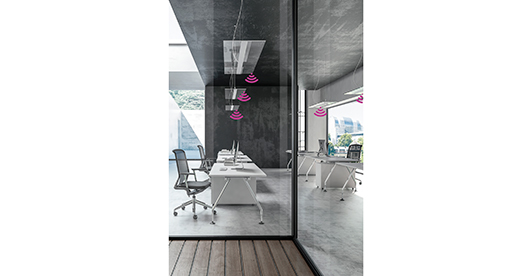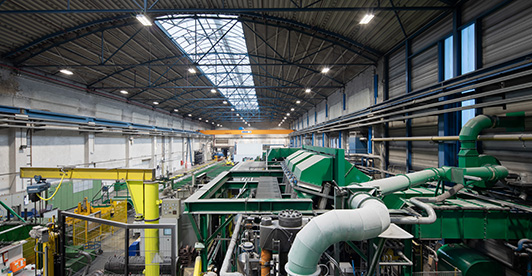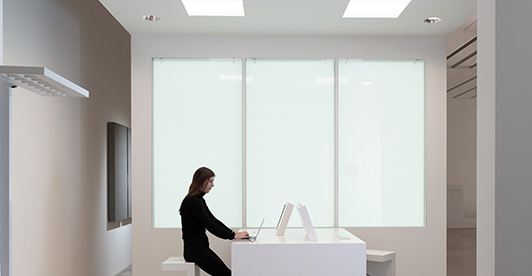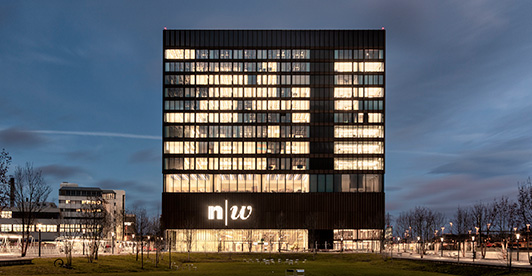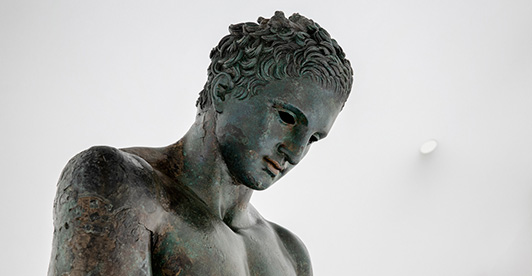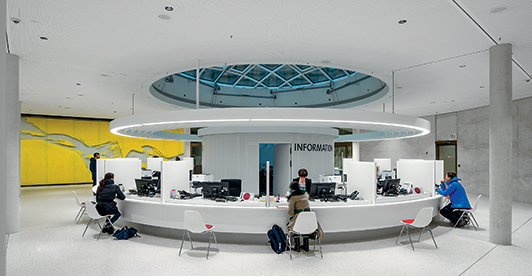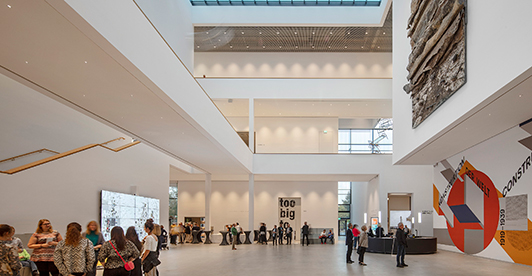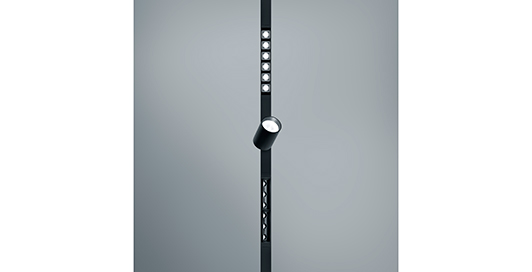Press Contact
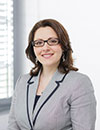
Press information 2019
-
06/2019Company
Zumtobel Group partners with technology innovator Casambi for wireless lighting control solutions
The Zumtobel Group, one of Europe’s leading professional lighting groups, with its core brands Thorn, Tridonic and Zumtobel, has teamed up with Casambi, a multi-award winning pioneer in wireless lighting controls based on Bluetooth Low Energy (BLE).More informationLess information“Our partnership with Casambi allows us to combine our outstanding luminaire design with state-of-the-art Bluetooth technology which simplifies installation, commissioning and operation of lighting systems and, thanks to its interoperability, leaves room for future developments and applications,” confirms Alfred Felder, Zumtobel Group CEO.
Casambi’s CEO Timo Pakkala endorses the partnership by commenting: “With Casambi technology installed within the Thorn and Zumtobel luminaires and also supporting Tridonic drivers, lighting control has become more powerful, versatile and easier to use. Moreover, the introduction of these new connected lighting solutions from an industry titan such as Zumtobel Group goes a long way to demonstrate the continued rapid growth achieved by Casambi’s expanding ecosystem.”
Casambi’s control technology platform, which automatically forms an intelligent wireless mesh connected network, enables luminaires and other lighting devices to be wirelessly controlled in a creative, cost effective, energy saving way.
Customers who choose Casambi Ready luminaires developed by either Thorn or Zumtobel benefit from the easy-to-install solution because they no longer need to use separate lighting control modules. Both lighting brands’ luminaires are mounted with Casambi-Ready modules which are integrated directly into Tridonic drivers. Thanks to the high-end features of the technology the luminaires can be easily controlled separately or in multiple groups and dimmed up and down between 1 and 100 percent – all via Bluetooth. Additionally, it is also possible to quickly organise and manage professional lighting scenes and create sophisticated tuneable white applications.
The luminaires will be of particular benefit to operators of offices, healthcare practices and shops looking for a quick and convenient way to modernise their lighting without any new cabling. They will then have a powerful, low-cost light management system that can be easily controlled via Bluetooth. For ultimate ease of use, individual users can control the lighting via the free the 4remote BT app developed by Tridonic or an optional wall mount user interface.Zumtobel. The Light.
-
share it
-
-
02/2019Lighting Solution
Leasing instead of purchase – Lighting without budget burdens, but with optimum quality checks thanks to COESA
Zero stress with a turnkey lighting solution: The ST Extruded Products Group (STEP-G) is taking advantage of a very special service after opting to renew the lighting at its Bitterfeld plant in the German state of Saxony-Anhalt. Comprehensive Zumtobel financing services and a complete-supply package have helped STEP-G benefit from a tailored lighting solution without major investment costs – and without major effort. When it comes to quality checks, the COESA luminaire ticks all the boxes with its unique lighting for surface inspections – something to which STEP-G, as one of the world’s leading manufacturers of extruded aluminium profiles, attaches particular importance.More informationLess informationEnter the STEP-G production hall in Bitterfeld and you immerse yourself in pure and daylight-bright lighting. Uniform light reaches into every corner of the room and is brilliantly reflected in the aluminium profiles that are manufactured here. Yet this application manages to simultaneously prioritise high lighting quality with high product quality, thanks to the unique technology of the COESA luminaire. With its high-contrast light lines, this solution specifically helps workers who are tasked with inspecting the surfaces of the finished profiles. This is outstanding quality – in terms of both the lighting and the premium products for which STEP-G has become famous the world over.
The international aluminium specialist was keen to modernise their existing lighting solution – without having to budget for high initial purchase costs. Wishful thinking? In the past, perhaps. But not anymore. Now financing services from Zumtobel make this possible. Instead of simply buying Zumtobel luminaires, STEP-G has chosen to lease the entire lighting solution over a defined time period. And so light becomes a service, meaning that STEP-G no longer has to think about hefty initial investment costs. Plus the company remains completely flexible when it comes to lighting and can benefit straight away from new and innovative lighting solutions. This is a true turnkey project, as Zumtobel has looked after the entire project management – starting with the supply of materials and going on to include installation, interface coordination, commissioning and regular inspections. And all this from one single source. “With the financing offer from Zumtobel Services, STEP-G no longer has to think about lighting and quality for the entire term of the contract,” confirmed Daniel Weber, Project Manager Turnkey at Zumtobel.
The STEP-G plant in Bitterfeld, where extruded aluminium profiles are manufactured, tested and processed, is now illuminated by a modern lighting solution that supports both the production and the all-important surface inspections. This is where COESA, the first-ever LED quality-control luminaire from Zumtobel, really comes into its own. The fitting combines colour temperature contrasts with precise colour lines to enable flawless surface illumination. A blend of neutral and cold-white colour temperatures, arranged longitudinally, is reflected in the aluminium profiles in a linear and high-contrast way to create the optimum environment for casting a careful eye over the shiny surfaces. When the quality is flawless, observers viewing the metal at a specific angle see a clean reflection made up of perfect linear lines. Yet if something is not quite right, the lines are suddenly interrupted or distorted. This produces a reflection that appears warped and uneven and therefore helps make sure that any defects and irregularities are detected immediately. Workers can then react right away and remove any faulty aluminium profiles before shipment. Simple. And most definitely effective.
The tried-and-tested TECTON LED continuous-row lighting system from Zumtobel provides general illumination in the halls, while CRAFT LED high-bay luminaires deliver precise light from above. With high light levels optimised for high ceilings and excellent thermal management, CRAFT is ideally equipped for just these kinds of industrial sites. Potentially tricky atmospheric issues are also easily overcome, as this powerful solution has been engineered to minimise the amount of dust and dirt that gathers on the luminaire.
Zumtobel has used this new solution to markedly improve the lighting quality and thereby make a real difference in the production halls. The overall lighting level has increased – no matter where you are in the factory. There has been a positive effect on employee fatigue. Flickering light has become a thing of the past. And compared to the previous installation, the solution is now much more efficient – both in terms of lighting technology and energy. “A carefully planned lighting solution has enabled us to significantly simplify important jobs for the employees, especially in the key area of surface inspection,” confirmed Gerhard Backhaus, Project Manager at Zumtobel. “The enhanced visibility allows any defects to be identified and rectified straight away.”
“The whole project and the entire cooperation went very smoothly. The implementation phase was extremely quick and – in some cases – could even take place alongside normal production, without any manufacturing downtime,” reported STEP-G.Zumtobel. The Light.
-
share it
-
-
02/2019Company
The future of light is digital: Zumtobel teams up with pureLiFi to step into the wireless enterprise network market
Zumtobel, one of the European market leaders for professional lighting and associated services, is striving for the use of their innovative LED solutions to empower the latest in wireless technologies called LiFi.More informationLess informationThe newest trial, conducted in partnership with pureLiFi, uses LED lights to send large amounts of data while appearing as normal LED light to the human eye. The LiFi trial reflects a series of moves by Zumtobel to evolve lighting beyond its core function of pure illumination and solve challenges for high-speed secure wireless connectivity.
As part of the trial, Zumtobel has installed pureLiFi’s system, alongside its LED lights. The system enables a data transmission via an LED luminaire at high speeds through small adjustments in the LED’s brightness. The result is a high-speed Internet connection that is more secure, reliable, and able to deliver bandwidth far beyond the capabilities of conventional wireless communications like Wi-Fi.
LiFi is more secure and virtually interference free compared to other wireless solutions. The technology will enable to leverage vast frequency spectrum resources of visible light. Zumtobel aims to evaluate the market demand for this ground-breaking technology over the coming months. Therefore, Zumtobel will leverage LiFi to create value for lead adopters from industries such as medical, defence, industrial and manufacturing.
“LiFi enabled by Zumtobel allows to step into the next era of wireless communications. Compared to standard radio technology or cellular such as Wi-Fi, LiFi can transmit at multiple gigabits, is more reliable, virtually interference free and uniquely more secure,” says Zumtobel Group CEO Alfred Felder and added, “we believe that in an increasingly interconnected digital world LiFi will play a decisive role in moving our industry into the era of digital light.”
Alistair Banham, pureLiFi CEO, says, “Zumtobel is one of the European market leaders for professional lighting and associated services. Currently, 80 percent of mobile wireless communications globally happens indoors. By offering connectivity alongside their innovative LED lighting technology, Zumtobel has the potential to become a leading supplier of high bandwidth data communication.”
pureLiFi will be exhibiting Zumtobel LED technology alongside their next generation LiFi solutions at Mobile World Congress, the world’s largest exhibition for the mobile industry. The exhibition will include a showcase of gigabit ready LiFi components in exciting commercial form factors, demonstrating LiFi is ready for commercial adoption.Zumtobel. The Light.
-
share it
-
-
02/2019Lighting Solution
Thirteen kilometres of light for science: the new editions luminaire FREELINE
The latest addition to the FHNW Campus Muttenz in Switzerland is certainly impressive: a cube-shaped building with an edge length of almost 65 metres that rises up to catch the eye from far and wide. Designed by pool Architekten, this is a simple and yet simultaneously monumental construction. And one that is purely devoted to education and research. Zumtobel joined forces with lighting designers from Reflexion to engineer a new luminaire for this extraordinary building: the FREELINE. Now more than 13 kilometres of this clever solution have been delicately woven into the imposing architecture.More informationLess informationIt is a real powerhouse. A striking new building created by the Swiss pool Architekten studio for the University of Applied Sciences (FH Nordwestschweiz) in Muttenz in Switzerland. Flanked by a tree-lined park and with an extensive forecourt, the 65-metre-tall cube looms over the neighbouring railway tracks. The copper-coloured façade shines invitingly in the sun. And inside, two spectacular atriums offer stunning views up to the sky – all framed by a potent yet uncomplicated style of architecture. There is hustle and bustle everywhere, but that is no real surprise: Around 4000 students and 840 employees come here every day to study. Or to teach. Or to carry out research. Zumtobel has developed the FREELINE luminaire with the Swiss lighting design agency Reflexion und pool Architekten for this bastion of knowledge and understanding – a solution that has now become part of our special collection known as the editions.
“The architecture of the new building is extremely rigorous and has a strong graphic quality," reported Thomas Mika, Managing Director of Reflexion and the person responsible for the lighting concept of the university building. “So we opted to integrate all the luminaires as far as possible into the existing elements.” This move emphasises the simplicity of the monumental construction, in which a visible concrete support structure and, in stark contrast, the use of warming wood combine to set the overall tone of the project. Diverse daylight situations generate varied atmospheres and spatial impressions. The foyer on the ground floor offers an ideal space to arrive and linger a while, while there is also room for an auditorium, a cafeteria and the “Cube” campus restaurant. Ramp-like staircases with a width of almost three metres form an architectural focal point. They traverse the atrium and stretch up to the two auditorium levels on the first and second floors. Almost like sculptures. Further highlights include the library on the third floor, where a wide band of windows adds structure to the façade, and a roof garden on the 12th floor, where users can enjoy a pleasant green oasis. And it is not just all about the building itself: The unique views of the surrounding area from the office and seminar rooms never fail to make an impression.
“For a project of this size, the lighting concept needs a main layer that connects the different rooms across the entire building and weaves itself into the architecture,” explained Mika. The ribbed concrete ceilings define the office, seminar and laboratory rooms, along with the corridors of the new university building, from the third to the twelfth floor. Reflexion opted to insert a linear luminaire between each of the ribs, enabling the spaces to be characterised by uniformity in terms of both light density and lighting design. Rather than just a simple two-dimensional band of light, the planners wanted to use contoured three-dimensional illumination to accentuate the architecture and, at the same time, light up the workspaces. Reflexion came to Zumtobel with this request and worked with experts from our Atelier of Light to develop a special luminaire: the FREELINE.
FREELINE really impresses with its simple elegance. The shape of the luminaire is determined by nothing more than a slim aluminium U-profile and a PMMA diffuser, with the control gear stored remotely to enable a truly miniaturised design. “A three-dimensional light-emitting surface is needed to create light with a real physical presence,” pointed out Mika. “However, lateral light-emitting surfaces are especially problematic in office applications, as people want to work in a glare-free environment.” The FREELINE features a primary and secondary optic to solve this tricky issue. The primary optic consists of a high-performance lens, which pools the light from the LED band, and a diffuser, which precisely directs the light to the emission surface at the bottom of the aluminium profile. The secondary micro-prismatic optic (MPO) guarantees the kind of accurate light control required in office applications and thereby helps make sure that FREELINE meets the requirements for UGR19. Thomas Mika from Reflexion was very positive about the whole design process: “The cooperation with Zumtobel was both a creative and a technical triumph. And that is what really sets Zumtobel apart: the ideas and plans of the client are implemented accurately and with great sensitivity.”
Two models of FREELINE have been created. Same appearance, different optics – and therefore different applications. While the MPO`s precise light control makes one version ideal for office and school projects, the lenticular optics of the second variant delivers an asymmetric light distribution that beautifully picks out architectural features. This fitting can used for wallwashing or blackboard illumination, like in the seminar rooms at the FHNW Campus Muttenz.
The FREELINE definitely lives up to its name at the University of Applied Sciences, where more than 13 kilometres of the solution stretch through the new building. Yet it was not just the elegant design and flexible usability that pleased the client. The FREELINE also reduces the need for specially trained personnel on site, as it can simply be mounted directly onto a low-voltage rail. Minor effort, major plus – especially in Muttenz, as the university was keen to move into the premises before the start of the 2018/19 winter semester. Quick and easy installation was therefore just as important as the large quantities that Zumtobel were able to provide in the shortest development and production time possible.Zumtobel. The Light.
-
share it
-
-
01/2019Lighting Solution
Apoxyomenos of Lošinj – from the depths of history to the light of the present day
The Muzej Apoksiomena in the Croatian town of Mali Lošinj tells the emotive story of the statue of Apoxyomenos – the “Lošinj Athlete” that was discovered in the sea just off the coast of the island of Lošinj. Scenic rooms staged by Zumtobel lighting solutions take visitors on a fascinating journey into the ancient world.More informationLess informationNobody knows how long and how come the 2000-year-old bronze statue of Apoxyomenos was resting at the bottom of the Mediterranean. Amateur divers only found it by chance in 1996. Partly concealed in the sand at a depth of 45 metres and covered with shells and seaweed, the figure was eventually recovered from the seabed three years later. All experts agree: The Greek athlete discovered off the coast of Lošinj is a truly unique find. Following six years of meticulous restoration work, Croatian architects Idis Turato and Saša Randić have designed a new museum for Apoxyomenos. Together with the architects and various other planners, Zumtobel has come up with a tailor-made lighting concept that uses a wide range of LED lighting solutions to really bring the story of the statue to life.Lush vegetation, rolling hills and a mild Mediterranean climate – Mali Lošinj is a stunning location on the island of Lošinj in the middle of the azure-blue northern Adriatic Sea. Muzej Apoksiomena is situated in the old Kvarner Palace on the waterfront. At first glance, the building barely stands out from the neighbouring houses. Yet look a little harder and the eye is drawn to a glass roof structure and a covered entrance area, which is actually an expansive balcony. Another special feature is revealed as evening approaches: coloured rays of light. The outer wall and balcony then appear as a composition of coloured surfaces that exert an irresistible attraction. RGB wall luminaires from the IKONO LED family and floor-recessed PASO II fittings from Zumtobel installed here offer a taste of what really sets this construction apart. This is a unique treasure chest – a museum that houses a lovingly designed spatial concept in which visitors pass through carefully staged rooms to slowly become familiar with Apoxyomenos and its fascinating history. “Like in scenes from a Stanley Kubrick film, visitors experience a museum that unfolds in rhythmic sections in front of their very eyes,” explained Turato when asked to define this special concept.
The first image of this visual journey is the seabed. On entering the museum, visitors find themselves in a hollowed-out building with bright cobalt-blue walls. A freely positioned white steel structure seems to hover above, with roughly welded steel plates that somehow resemble the hull of a powerful ship. The SUPERSYSTEM II multifunctional LED tool from Zumtobel installed in low-voltage tracks on the steel body and LED strips integrated into the floor along the walls combine to focus attention on these room-defining elements. As a key part of the overall room concept, the light sources themselves remain discreetly in the background.
An escalator concealed in a white sheet-steel tube leads up inside the spatial sculpture to the first exhibition space. Here, in soft light provided by back-lit wall panels and tables, visitors are offered their first insights into the historical significance, location and restoration of the statue. The story continues in the neighbouring cinema, where a colourful interior design evokes images of aquatic plants. This impression is created by completely covering the seating steps, walls and ceiling with floral patterns made from hand-woven merino wool. The general impression of an underwater world is reinforced by floor-recessed PASO II LED RGB luminaires, which use flowing colour transitions to generate a murky subaquatic atmosphere.
Visitors then wander up a completely red staircase into the media room, which does more than just demonstrate how the story of Apoxyomenos has been received and reported all over the world. It is here where the Greek athlete can be seen for the first time in all its original glory through an opening in the ceiling. Another staircase with vibrant olive-wood wall panelling leads to the top floor, where items discovered inside the figure on the seabed – such as branches, herb seeds and olive stones – are displayed in small, wall-mounted showcases. Precise accent lighting of the objects is achieved with the help of the miniaturised MICROTOOLS LED lighting system.
Without any colours and – above all – without any hint of shadow, the white main chamber that houses the actual Apoxyomenos statue represents the mystical high point of the museum. The special aura, which really puts the focus on the 1.92-metre-high bronze figure, is achieved with the help of a white floor and white textile walls that seem to merge seamlessly into the ceiling. An indiscernible light solution with invisible light sources was required to support this dematerialising effect. The challenge was met by a constellation of Zumtobel’s wide-area CIELOS LED luminaires – not flush-mounted, but with LED strips inserted between each fitting. The result: no discernible joins on the textile surfaces between the individual elements. In deliberate contrast, light surfaces installed diagonally to the direction of the glass floor tiles create a kind of visual foundation.
Moving on from the main chamber, visitors finally reach a completely black stairwell illuminated by LINARIA light lines. This space, featuring a glass roof structure that was already visible from the waterfront, has been finished off with a kaleidoscopic-type mirrored ceiling that offers views over the picturesque bay of Mali Lošinj.
The Muzej Apoksiomena is a real spatial artwork – a fine structural composition that impressively presents Apoxyomenos and shows how the statue emerged from the depths of the sea to finally once again see the light of day. Zumtobel LED luminaires, which can be controlled using the LITECOM lighting management system and are dimmable for dramatic effect, play a significant role throughout the building in helping to tell this unique story in all its fascinating glory.
Zumtobel. The Light.
-
share it
-
-
01/2019Lighting Solution
Setting new standards: Freiburg Town Hall is Germany`s first net plus-energy administration building
Natural shapes. Solar panels on a protective cover crafted from glass and wooden slats. Bright interiors that ooze discreet elegance. A human scale. All of these aspects are perfectly reflected in the new Freiburg Town Hall. In addition, LED lighting solutions specially developed by Zumtobel in collaboration with ingenhoven architects, Tropp Lighting Design and the City of Freiburg authorities help the building generate more energy than it actually uses. A very positive outcome – in every sense.© HG Esch Photography
More informationLess informationA six-storey building. Nestled behind large sycamore trees. And yet it is neither the size nor the situation of the new town hall that first catch the eye. It is the shape: a natural oval form that cannot help but inspire curiosity. Move a little closer and an intriguing glass façade comes slowly into view. A façade with slender storey-high slats that stretch around the building. A façade with slats that are light larch wood on one side and full-scale photovoltaic panel on the other, simultaneously shaping and showing the core characteristics of the new town hall in the German city of Freiburg: stylish and functional design with pioneering energy efficiency based on a concept devised by general planning consultants DS Plan. In close cooperation with ingenhoven architects, Tropp Lighting Design and the city of Freiburg authorities, Zumtobel set about developing customised energy-efficient LED lighting solutions for the offices, the Public Service Centre and the canteen. The results are now an essential part of the clearly structured and ergonomic work and service areas for the 840 employees who were previously spread across various different locations. And that is not all: These solutions have also played a major role in enabling Freiburg Town Hall to become Germany's first net plus-energy administration building.
Around 1000 visitors a day make their way across the square in front of the town hall and head through the porch into the Public Service Centre. This is where people can apply for official documents and take advantage of the range of services offered by the city authorities. And this is where windowless corridors with individual offices have now given way to a spacious hall in elegant white – flooded with light – that takes up the whole of the oval inner quadrangle. And then the eyes are drawn upwards. First to the large round glass skylights and then on to the wooden façade of the five office floors and finally the sky above Freiburg. Only then do visitors notice the four round service islands.
With a diameter of around 10 metres, these “rotundas” feature a central cylinder that houses a discreet private area flanked by circular consultation zones. Above each of these stations hangs a delicate lighting ring, suspended from the ceiling, which emphasises the rotundas as islands of light in the hall. At the same time, this ring illuminates the workspaces without the need for any additional fittings. Working alongside the planners and Fries Innenausbau, the manufacturer that developed the rotundas as integrated furniture systems, Zumtobel was asked to come up with a lighting solution that hits strict targets in terms of atmosphere and simultaneously fulfils various other requirements.
Creative-constructive aspects were just as important as the specifications defined by the City of Freiburg authorities for workplace lighting exposure and sustainability. Glare-free light without the unwelcome sight of discernible LED points has been achieved thanks to a multilayer luminaire structure incorporating a diffuser and micro-prismatic optics. The crucial increased colour rendering index (CRI) > 90 guarantees maximum light quality and colour authenticity. Interchangeable gear trays were also required to support the conservation of resources, enabling the lighting technology to be replaced without having to renew the custom-made luminaire housing and its sophisticated optical unit.
Two routes lead from the Public Service Centre to the internal offices on the upper floors. Elegant subdued colours, large-scale glazed facades and office partitions, as well as an open-plan layout, create a pleasantly bright working environment. An environment where easy orientation and open communication are actively supported. When it comes to light quality, colour authenticity and future-proofing, the linear luminaires suspended from the ceiling in the offices meet the same stringent requirements as the solution designed for the rotundas on the ground floor.
To help provide optimal support for visual tasks in the biaxial offices with just one luminaire, it was also necessary to be able to install the solutions in the middle of the axes of the office raster. Stepping up to this challenge, Zumtobel developed a 3-metre-long fitting based on the LINCOR product, combining a very slim cross-section of just 63 x 64 mm with an extremely high light output of 11,000 lumens. A perfectly defined colour temperature of 4000 Kelvin and outstanding glare reduction – thanks to the mini-cell structure – ensure excellent light quality, while the 70-30 ratio of direct light onto the workspace and indirect illumination of the ceiling also has a noticeably positive effect. Brightness and motion sensors are integrated into the luminaires for added comfort and, importantly, added efficiency. Speaking of efficiency, the light level is permanently adjusted to provide the required illuminance of 500 lux on the desks – but only when it is really needed. If all the employees have left the office, the luminaires are simply switched off. No users, no light, no waste.
Workers in the town hall have access to the staff restaurant on the ground floor at lunchtime – a large, completely white open space that echoes the look and feel of the Public Service Centre. The clear design creates a structured space in which features like vertical stripes of colour on the walls and wooden chairs generate a pleasant feeling. A warm feeling. And a welcome feeling. Recessed completely into the ceiling, special prismatic luminaires from Zumtobel meet the same exacting standards of design, quality and energy efficiency as the solutions in the work areas. High colour rendering of CRI > 90 also plays a key role in the restaurant, presenting the meals in just the right tones, with just the right light, for just the right effect.
Achieving this perfect blend of architecture, design and light to deliver the highest standards of well-being, design and energy efficiency have helped Freiburg Town Hall become Germany`s first net plus-energy administration building. Yet the awards and attention are in no way limited by national borders. Honours like the Balthasar Neumann Prize show just how this building has really shot to prominence on the international architecture scene. The Balthasar Neumann jury recognised the new Freiburg Town Hall as one of three projects that have been “realised in a very special way through interdisciplinary cooperation”. In addition, the building has won the German Sustainability Award 2019 from the German Sustainable Building Council (Deutsche Gesellschaft für Nachhaltiges Bauen or DGNB) in the ‘Sustainable Building’ category.Zumtobel. The Light.
-
share it
-
-
11/2018Lighting Solution
A creative powerhouse for the arts – Zumtobel lights up a new building at the Kunsthalle Mannheim
Showcasing art with light is a Zumtobel specialty. Planning and realising a high-quality and perfectly tailored lighting solution not only helps preserve works of art, but also supports both the overall concept of the exhibition and the architecture of the museum. And that is exactly what has been achieved in close cooperation with a·g Licht at the Kunsthalle Mannheim – the largest new building at a German art museum in recent years. As a cultural temple to the urban future of Mannheim, architects from the Gerkan, Marg and Partner (gmp) architectural office have crafted a design that creates an elegant “city in the city”.More informationLess informationAs an essential part of the curatorial concept, light fundamentally shapes the emotional perception of architecture and art, helping observers to make a real sensory connection with the pieces on show. The seemingly simple-looking new building at the Kunsthalle Mannheim, which was recently opened to much fanfare after three years of construction, houses a radical museum concept – a concept in which the emotions behind the art play a role. A key role. The 68.3-million-euro building is currently the largest new construction at an art museum in the whole of Germany and has attracted almost 90,000 visitors in the first three months. Yet it is more than just the exceptional idea of the museum that draws people here. The unique architecture has also caught the eye. The Kunsthalle Mannheim is in fact a “city in the city”, where ten cubes invite visitors to really engage with the most varied aspects of art.
The scale of the rooms and especially the atrium, a 22-metre-high space awash with daylight, placed special demands on the lighting concept – which is why a clever solution devised by lighting design agency a·g Licht was required to place the 13,000 square metres of floor space in just the right light. Various factors helped Daniel Walden from a·g Licht make the call to involve Zumtobel with this lighting concept (and not just the long-standing cooperation between the two companies). “Zumtobel impressed with a high degree of lighting comfort and light quality, but also with their extensive portfolio of accessories, which has enabled us to tailor the light intensity and thereby accurately meet the changing requirements of the exhibition lighting. Because that is exactly what the “museum in motion” concept needs: flexibility and adaptability,” explained Daniel Walden.
A highly adaptable and individually tailored lighting installation has been carefully designed for the first special exhibition: assorted works by the photo artist Jeff Wall, which ran until the start of September. However, while the lighting installation at the Kunsthalle perfectly showcased Wall's concept photography exhibition, Zumtobel has also made sure that the solution can provide optimal staging for other exhibitions in the future. Just like “The Construction of the World: Art and Economy” (Konstruktion der Welt: Kunst und Ökonomie), the first major theme-based exhibition at the Kunsthalle Mannheim that opened on 11. October 2018. The exhibits and the atrium are highlighted using ARCOS 3 LED xpert spotlights. The result: flawless accents and excellent efficiency. Indeed, the museum has already ordered another 250 ARCOS 3 LED xpert fittings to further extend the installation. At the same time, the DIAMO and PANOS infinity lighting systems have been combined with illuminated ceilings to deliver ideal illumination at all times in the spaces adjacent to the exhibition cubicles. All thanks to various personalisation options and high-quality accent lighting. This unique lighting installation has made the theory of a “museum in motion” a reality – and at the same time given exhibits a fresh and truly authentic appearance.
The visionary building design from gmp Architekten integrates urban quality through a refined interior structure. In terms of the architecture, the construction meets all the requirements of the 21st century – in much the same way as the pioneering lighting concept. Daniel Walden and the lighting designers at a·g Licht in Bonn have been working together with Zumtobel for years. So they certainly appreciate the intensive partnership-based cooperation offered by the in-house lighting experts from the lighting manufacturer’s “Atelier of Light” project-planning department. This is where flexibility, versatility and customer focus are key – three cornerstones of the Zumtobel approach.Zumtobel. The Light.
-
share it
-
-
11/2018Products
SUPERSYSTEM integral collection by: EOOS – the ultimate set of architectural lighting instruments
The new Zumtobel SUPERSYSTEM integral collection designed by the renowned Austrian studio EOOS from is something special. This comprehensive range of carefully miniaturised tools offers one high-quality solution for countless architectural lighting tasks. How? By fusing pure integrated design with maximum adaptability for both the application and the architecture. Seamlessly. Like never before.More informationLess informationSUPERSYSTEM has somehow always been an example of nominative determinism – the idea that an outcome is driven by a name. Super and system: These two words perfectly sum up this acclaimed product family’s unique status as a portfolio of outstanding lighting solutions. Just ask the thousands of lighting designers who have realised challenging installations with SUPERSYSTEM over the years. Or the architects who have specified this stylish range for stunning design-led projects all over the world. Now the SUPERSYSTEM integral collection from Zumtobel takes this concept one step further by integrating an extensive range of lighting instruments into one highly flexible holistic lighting solution. The result: a truly super system.
Designing the lighting for indoor architectural applications is often a tricky business. For example, take a moment to consider the varied lighting tasks in a single museum, shop or office. See what we mean? Complex challenges require comprehensive solutions – which is why the SUPERSYSTEM integral collection features the widest selection of architectural lighting instruments around. One range offers adjustable accent lighting with spots or gimbals, horizontal downlighting, perfect vertical wallwashing and pleasant indirect lighting. And this is quantity without sacrificing quality. Each version has been carefully engineered for the exact needs of the particular job. Just take a look at the clever functionality of the unique synchro gimbal fitting. Simple, clever design manages to deftly combine a rotatable downlight with the linear topology of SUPERSYSTEM integral. Or step back and appreciate the identical wallwashing characteristics guaranteed by the Litecarve free-form reflector. And while the distribution can be adapted to the task, one thing stays the same: the high level of visual comfort. All across the range. Low brightness with minimal light spill, outstanding glare control and the use of deep-source reflectors make sure this solution meets the highest standards demanded by Art and Culture, Retail and Office applications.
Different requirements used to mean different products. But not any more. As the name suggests, the SUPERSYSTEM integral collection integrates all these options into one pure design concept. Thanks to the renowned Austrian studio EOOS. However, once again, the issue of flexibility also comes to the fore. Why should lighting designers be the only ones to benefit? Depending on the nature of the particular application, architects can select a version to suit every interior architecture. And every taste.
“The comprehensive planning tool is based on the poetic idea of stringently miniaturising the spotlight heads, enabling them to be perfectly integrated into a continuous linear structure. The system magically emits light from a slender groove as a recessed or track fitting. SUPERSYSTEM integral even makes it possible to adapt existing track installations, which improves efficiency and saves resources – and helps this system make an important contribution as a sustainable design solution.” (Harald Gründl, EOOS)
A definite design highlight is the seamless linear 3-phase channel that can be recessed into the ceiling, surface mounted or suspended. All the different lighting elements are fully integrated into the slender channel, providing invisible illumination at its very best. Yet sometimes solutions are made to be seen – solutions like the elegant 3-phase track version for surface or suspended mounting. Ideal for refurbishment projects. Consistent miniaturisation and high-quality materials like die-cast aluminium and injection-moulded plastics blend to create a refined architectural appearance that can grace both new and retrofit projects. Suddenly the days of installing bulky spotlights on a clearly distinct track seem long gone. If these sophisticated linear track versions are still not enough, simple (yet effective) individual standalone versions can be specified to really underline the outstanding flexibility of this range. And when it comes to taste, a choice of white, black, copper and glossy aluminium finishes should give architects and end-users plenty to think about.
Talking of choices, the SUPERSYSTEM integral collection also covers all bases when it comes to photometric performance, lighting characteristics and controls. An output of up to 3000 lumens makes this range a real alternative for applications where traditional downlights have generally been the only option. A stylish alternative. And an alternative with up to 75 lumens per Watt, to be precise. Colour temperatures of 2700 K, 3000 K and 4000 K suit various different requirements, while excellent colour rendering of Ra 90 comes as standard. As does visual comfort. Yet good visual comfort also means good lighting management, which is why versions with DALI and basicDIM wireless via Bluetooth ensure added adaptability and tailored light that stimulates the senses, creates experiences and protects sensitive objects. What else would you expect from a solution that embodies the core principles of our pioneering Active Light approach?
The SUPERSYSTEM integral collection from Zumtobel. It really is all in the name.
Zumtobel. The Light.
-
share it
-
Presse Newsfilter
Downloads
RSS-Feed
» RSS feed
Videos
» Zumtobel YouTube channel

